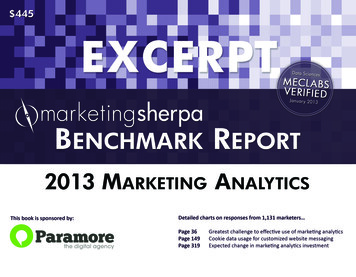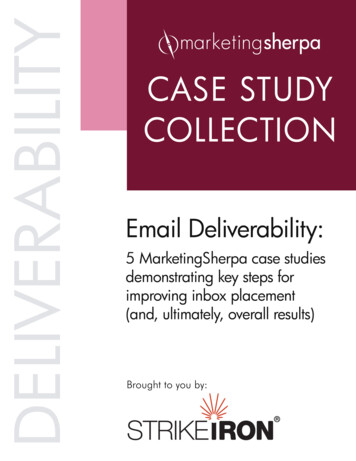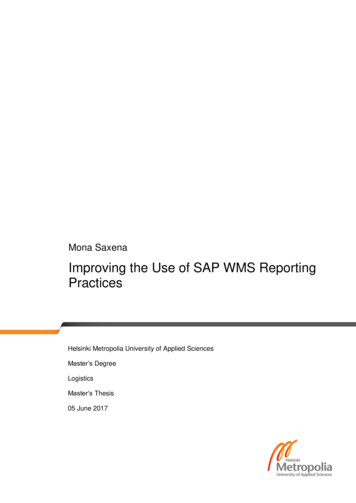
Transcription
Stop reporting. Start improving.The days of "launch it and leave it" are over. Project development, media buying and website and campaign launches are merely the first steps toachieving success with your digital work. Da Vinci said it best, “Art is never finished, only abandoned.”Don't abandon your digital campaigns. Seriously, they’ll get a complex.Digital's big promise has always been that you could know more about your customer from it than you ever could from its traditional counterparts. Sincethe beginning we've had measurement of people's response to digital media in some form from the most rudimentary click-through to the moresophisticated conversion funnel. But using that information to make our marketing better has eluded us. Why? Because most people don't take the timeto digest and act on what they've measured.Look in the mirror and say this with us:Stop reporting. Start improving.Analytics applications can now provide tangible evidence of how your websites and digital media campaigns are performing. You can see the how andwhy behind every scroll, click, and conversion.But it’s not just about delivering fancy spreadsheets with a bunch of numbers and some high-level marketing speak about what it all means. It’s aboutusing the analytics to reflect, react, and then repeat.It's no longer enough to just use traditional clickstream analytics. Simply measuring page-views and path analysis doesn’t lead to action. Combiningclickstream and voice of customer analysis allows us to measure things like task completion rates and segmented visitor trends giving us actionableinsights that we can then use to improve a website or campaign’s performance.The more usable your website is the better it is for both your users and for search engines. The more personal, targeted and engaging your media is, themore customers you'll get. By continuing to modify and optimize a site design or landing page throughout its life cycle, you’ll not only have highperforming campaigns, you’ll have happier clients.Paramore serves its clients by creating websites and digital media campaigns that are simple, clear andfocused on results. To learn more about how we think, visit our blog: paramoredigital.com/think.
2013 Analytics Benchmark ReportHIGHLIGHTSWelcome to MarketingSherpa’s inaugural benchmark study of marketing analytics. Inside, you’ll find data culled from a survey ofexpert marketers.Our goal for this report is to help you craft an effective marketing analytics plan through invaluable data about marketing analyticspractices, insights, tools, challenges, objectives and budgetary concerns, based upon feedback and data from an international field ofmarketers, across a wide range of industries, company sizes and customer types.The 1,131 marketers who participated in our research helped us to identify: Marketers’ collection of marketing analytics, by industry, customer type and company sizeInsights gained from marketing analytics dataAnalytics tools used by marketersChallenges faced by marketers when using analytics toolsHow marketers use their analytics platformsHow analytics plays a role in message developmentHow marketers quantify the economic value of website conversionsWhich metrics marketers track for their organizationsHow marketers track metrics for the following channels:o Social media marketingo Email marketingo SEO marketingo PPC marketingo Display advertisingo Video marketingo Content marketing Marketers’ analytics objectives for 2013Marketers’ analytics challenges from 2012How marketers better understand their prospects and customersHow marketers measure revenue and costsHow analytics will fit into marketers’ budgets for the coming year3
2013 Analytics Benchmark ReportCOPYRIGHTUse this data to gain approval, win clients, and help fellow marketersAt MarketingSherpa, our goal is to give marketers the instructions, statistics, and inspiration to improve theirresults. To that end, you are free to share any five (5) charts from this book in presentations to clients,business leadership, and at events as well as in blog posts, videos and other public and private venues,without written permission, as long as you attribute MarketingSherpa and link to MarketingSherpa.com(where applicable).However, if you would like to use more than five charts, please request written permission from the publisherat research@meclabs.com or (877) 895-1717. Outside the US and Canada please call (401) 383-3131.US 445 / ISBN: 978-1-936390-54-0 2013 by MarketingSherpa LLCAll rights reserved. Five (5) charts from this report may be reproduced in presentations, blog posts, videos and other public andprivate venues without written permission, as long as content and data is not altered and charts are attributed to MarketingSherpaand link to MarketingSherpa.com (where applicable). Additional use required written permission from the publisher.To purchase additional copies of this report, please visit http://www.meclabs.com/trainingBulk discounts are available for multiple copies. Contact the publisher at research@meclabs.com or (877) 895-1717.4
2013 Analytics Benchmark ReportExecutive EditorFlint McGlaughlin, Managing DirectorSciences TeamDiana Sindicich, Senior Manager of Data SciencesEditorBrad Bortone, Senior Research EditorDesignerJohn Tackett, Editorial AnalystContributorsKaci Bower, Senior Research AnalystDaniel Burstein, Director of Editorial ContentBob Kemper, Senior Director of SciencesTodd Lebo, Senior Director of ContentPamela Markey, Director of Marketing5CONTRIBUTORS
EDITOR’S LETTERDear Marketer,What are the most important metrics that you should be tracking? How do translate your metrics into the ability to predict customer behavior? Should you bemeasuring emerging channels such as social media and mobile?These are just few of the questions addressed in the new 2013 Analytics Benchmark Survey. Some of the most compelling findings may surprise you: Of those who do not use analytics data to make marketing decisions, 42% rely on gut instincts (Chart 1.25) Performance of previous messages is more routinely used by those who collect an average or larger amount of data (Chart 2.19) than those whoseorganization had limited data (Chart 2.20) Those who use paid analytics tools at some level (Chart 2.33) quantify the economic value of conversions on their website in more ways than those who onlyuse free tools (Chart 2.32)In this 325-page report, our researchers have distilled the most essential insights from over 1,100 surveys of companies from all over the world. There are 246charts in total – all of which are designed to help you make the most of your analytics programs.We have tried to cover the most pressing questions facing marketers in 2013. However, we know that there is always more to learn and discover. As you readthis book, I would not only love to hear what charts you found most helpful, but also what questions you would like to see addressed in the future.Once you have read (or at least skimmed) this material, you may have questions or recommendations. Please take the time to share your thoughts.Together, we can advance our understanding of analytics.Thank you for your trust,Flint McGlaughlinManaging Director, MECLABSP.S. For me, some of the most compelling findings are on pages 47, 294, and 312.6
TABLE OF CONTENTSEXECUTIVE SUMMARYTakeaway #1 Most Marketers have analytics data Takeaway #2 But aren’t always capitalizing on it Takeaway #3 Perhaps due to lack of resources and timeTakeaway #4 Marketers focus more on generating reportsthan gathering insightsTakeaway #5 More marketers routinely track engagement-based metricsthan revenue-based metricsTakeaway #6 Regulatory barriers are of little concern to the vast majorityof marketersTakeaway #7 Despite (or perhaps because of) analytics challenges, budgetswill likely increaseCHAPTER 1: THE MARKETPoints to ConsiderAnalytical data collectionHow much analytics data does your organization collect?Chart 1.1All responsesChart 1.2By customer typeAnalytics tool usageWhich analytics tools does your organization use?Chart 1.3All responsesChart 1.4By customer type (part 1 of 2)Chart 1.4By customer type (part 2 of 2)Chart 1.5Manufacturing or Packaged GoodsChart 1.6Media or PublishingChart 1.7Software or Software as a ServiceChart 1.8Technology Equipment or HardwareChart 1.9Marketing agency or consultancyChart 1.10Non-Profit and EducationChart 1.11Retail or e-commerceChart 1.12Chart 1.13Chart 1.13OtherBy company size (part 1 of 2)By company size (part 2 of 2)Leveraging analytics to gain marketing insightsAre you able to leverage your organization’s analytics data to gauge marketingeffectiveness?Chart 1.14All responsesChart 1.15By customer typeChart 1.16By frequency of use (or amount of data collected)Chart 1.17Manufacturing or Packaged GoodsChart 1.18Media or PublishingChart 1.19Software or Software as a ServiceChart 1.20Marketing agency or consultancyChart 1.21Non-Profit and EducationChart 1.22Retail or e-commerceChart 1.23Professional or Financial ServicesChart 1.24OtherNon-analytical decision making strategiesInstead of analytics data to make marketing decisions, we rely on:Chart 1.25All responsesChart 1.26By customer typeChart 1.27By decision making authority level (part 1 of 2)Chart 1.27By decision making authority level (part 2 of 2)Chart 1.28Software or Software as a ServiceChart 1.29Marketing agency or consultancyChart 1.30Retail or e-commerceChart 1.31Professional or Financial ServicesChart 1.32OtherChart 1.33By company size (part 1 of 2)Chart 1.33By company size (part 2 of 2)7
TABLE OF CONTENTSMarketing analytics benefit to organizationHow do marketing analytics most benefit your organization?Chart 1.34All responsesChart 1.35By customer typeChart 1.36By amount of analytical data collected (part 1 of 2)Chart 1.36By amount of analytical data collected (part 2 of 2)Analytics needed to increase marketing effectivenessIf I only had , my marketing efforts would be substantially more effectiveChart 1.37Chart 1.38Chart 1.38Chart 1.39Chart 1.40Chart 1.41Chart 1.42Chart 1.43Chart 1.44Chart 1.45Chart 1.46Chart 1.47Chart 1.47All responsesBy customer type (part 1 of 2)By customer type (part 2 of 2)Manufacturing or Packaged GoodsMedia or PublishingSoftware or Software as a ServiceMarketing agency or consultancyNon-Profit and EducationRetail or e-commerceProfessional or Financial ServicesOtherBy company size (part 1 of 2)By company size (part 2 of 2)Chart 1.53Chart 1.54Chart 1.55Chart 1.56Chart 1.57Chart 1.58Chart 1.59By industry and Web-integrated Call ManagementBy industry and PPC Bid ManagementBy industry and Email Marketing SoftwareBy industry and SEO ManagementBy industry and Social Media MonitoringBy industry and CRM SystemsBy industry and Competitive IntelligenceAnalytics tool precision and satisfactionAre you satisfied with the PRECISION of your analytics systems?Chart 1.60All responsesChart 1.61By analytics system and satisfaction with Free ToolsChart 1.62By analytics system and satisfaction with Paid ToolsInterpretation and application difficulty of analytics system outputIs the output from your analytics systems easy to interpret and apply?Chart 1.63All responsesChart 1.64By Business-to-consumer (B2C)Chart 1.65By Business-to-business/government (B2B and/or B2G)Chart 1.66By both B2B and B2CAnalytics tool cost and usageDoes your organization use free and/or paid tools?Chart 1.48All responsesChart 1.49Business-to-consumer (B2C)Chart 1.50B2B and/or B2GChart 1.51Both business and consumer salesChart 1.52By industry and Web (clickstream)8
TABLE OF CONTENTSGreatest challenges to effective analytics useWhich of the following do you consider the greatest challenge toeffective use of marketing analytics?Chart 1.67All responsesChart 1.68By customer typeChart 1.69Manufacturing or Packaged GoodsChart 1.70Media or PublishingChart 1.71Software or Software as a ServiceChart 1.72Marketing agency or consultancyChart 1.73Non-Profit and EducationChart 1.74Retail or e-commerceChart 1.75Professional or Financial ServicesChart 1.76OtherChart 1.77By company sizeCHAPTER 2: THE MESSAGEPoints to ConsiderAnalytics platform usage beyond default settingsHow do you use your analytics platform beyond the default set-up to trackmessage performance?Chart 2.1All responsesChart 2.2Business-to-consumer (B2C)Chart 2.3B2B and/or B2GChart 2.4B2C and B2BChart 2.5Marketing agency or consultancyChart 2.6Software or Software as a ServiceChart 2.7Retail or e-commerceChart 2.8By routine insights gained from analyticsChart 2.9By occasionally insights gained from analyticsChart 2.10Respondents whose web analytics tools were easy tointerpret and applyChart 2.11Respondents whose web analytics tools difficult to interpretand applyAnalytics usage for message creationWhich of the following do you routinely use to create different message types?Chart 2.12All responsesChart 2.13Business-to-consumer (B2C)Chart 2.14Business-to-business (B2B and/or B2G)Chart 2.15B2C and B2BChart 2.16Software or Software as a ServiceChart 2.17Marketing agency or consultancyChart 2.18Retail or e-commerceChart 2.19Organizations collecting average to large amounts of dataChart 2.20Organizations with limited dataUse of cookie data for customized message creationHow do you use cookie data to provide more customized messaging on yourwebsite?Chart 2.21All responsesChart 2.22Business-to-consumer (B2C)Chart 2.23Business-to-business (B2B and/or B2G)Chart 2.24B2C and B2BChart 2.25Software or Software as a ServiceChart 2.26Marketing agency or consultancyChart 2.27Retail or e-commerce9
TABLE OF CONTENTSEconomic value of conversionsDo you quantify the economic value of these conversions?Chart 2.28All responsesChart 2.29Business-to-consumer (B2C)Chart 2.30Business-to-business (B2B and/or B2G)Chart 2.31B2C and B2BChart 2.32Respondents who use free analytics tools onlyChart 2.33Respondents who use paid tool only or a mix offree and paid toolsCHAPTER 3: THE MEDIUMPoints to ConsiderMarketing metrics trackingWhich of the following metrics does your organizationROUTINELY track?Chart 3.1All responsesSocial media marketing metrics trackingWhich of the following social metrics does your organizationROUTINELY track?Chart 3.2All responsesChart 3.3Business-to-consumer (B2C)Chart 3.4Business-to-business (B2B and/or B2G)Chart 3.5B2C and B2BChart 3.6Marketing agency or consultancySocial media marketing metricsPlease enter your best estimate for the followingChart 3.7By visit-to-lead generation rateChart 3.8By opportunity-to-close rateChart 3.9By lead-to-close rateChart 3.10By sales conversion rateSocial marketing analytics tools satisfactionHow satisfied are you with the variety and quality of tools available for you tomeasure social marketing?Chart 3.11All responsesEmail marketing metrics trackingWhich of the following email marketing metrics does your organizationROUTINELY track?Chart 3.12All responsesChart 3.13Business-to-consumer (B2C)Chart 3.14Business-to-business (B2B and/or B2G)Chart 3.15B2C and B2BChart 3.16Software or Software as a ServiceChart 3.17Marketing agency or consultancyChart 3.18Retail or e-commerceEmail marketing metricsPlease enter your best estimate for the followingChart 3.19By open rateChart 3.20By clickthrough rateChart 3.21By lead-to-close generation rateChart 3.22By opportunity-to-close rateChart 3.23By sales conversion rateEmail marketing analytics tools satisfactionHow satisfied are you with the variety and quality of tools available for you tomeasure email marketing?Chart 3.24All responses10
TABLE OF CONTENTSSEO marketing metrics trackingWhich of the following SEO marketing metrics does your organizationROUTINELY track?Chart 3.25All responsesChart 3.26Business-to-consumer (B2C)Chart 3.27Business-to-business (B2B and/or B2G)Chart 3.28B2C and B2BChart 3.29Marketing agency or consultancyChart 3.30Retail or e-commerceSearch engine optimization marketing metricsPlease enter your best estimate for the followingChart 3.31By clickthrough rateChart 3.32By visit-to-lead generation rateChart 3.33By opportunity-to-close rateChart 3.34By sales conversion rateChart 3.35By lead-to-close rateSEO marketing analytics tools satisfactionHow satisfied are you with the variety and quality of tools availablefor you to measure SEO marketing?Chart 3.36All responsesPPC marketing metrics trackingWhich of the following PPC marketing metrics does your organizationROUTINELY track?Chart 3.37All responsesChart 3.38Business-to-consumer (B2C)Chart 3.39Business-to-business (B2B and/or B2G)Chart 3.40B2C and B2BChart 3.41Marketing agency or consultancyPPC marketing metricsPlease enter your best estimate for the followingChart 3.42By clickthrough rateChart 3.43By visit-to-lead generation rateChart 3.44By opportunity-to-close rateChart 3.45By sales conversion rateChart 3.46By lead-to-close ratePPC marketing analytics tools satisfactionHow satisfied are you with the variety and quality of tools available for you tomeasure PPC marketing?Chart 3.47All responsesDisplay advertising metrics trackingWhich of the following display advertising metrics does your organizationROUTINELY track?Chart 3.48All responsesChart 3.49Business-to-consumer (B2C)Chart 3.50Business-to-business (B2B and/or B2G)Chart 3.51B2C and B2BChart 3.52Marketing agency or consultancyDisplay advertising metricsPlease enter your best estimate for the followingChart 3.53By clickthrough rateChart 3.54By visit-to-lead generation rateChart 3.55By opportunity-to-close rateChart 3.56By sales conversion rateChart 3.57By lead-to-close rateDisplay advertising analytics tools satisfactionHow satisfied are you with the variety and quality of tools available for you tomeasure display advertising?Chart 3.58All responsesVideo marketing metrics trackingWhich of the following display advertising metrics does your organizationROUTINELY track?Chart 3.59All responsesChart 3.60Business-to-consumer (B2C)Chart 3.61B2C and B2BChart 3.62Marketing agency or consultancy11
TABLE OF CONTENTSVideo marketing metricsPlease enter your best estimate for the followingChart 3.63By visit-to-lead generation rateChart 3.64By opportunity-to-close rateChart 3.65By sales conversion rateChart 3.66By lead-to-close rateVideo marketing analytics tools satisfactionHow satisfied are you with the variety and quality of tools available for you tomeasure display advertising?Chart 3.67All responsesContent marketing metrics trackWhich of the following content marketing metrics does your organizationROUTINELY track?Chart 3.68All responsesChart 3.69Business-to-consumer (B2C)Chart 3.70Business-to-business (B2B and/or B2G)Chart 3.71B2C and B2BChart 3.72Software or Software as a ServiceChart 3.73Marketing agency or consultancyContent marketing metricsPlease enter your best estimate for the followingChart 3.74By content consumption rateChart 3.75By lead generation rateChart 3.76By opportunity-to-close rateChart 3.77By sales conversion rateContent marketing analytics tools satisfactionHow satisfied are you with the variety and quality of tools availablefor you to measure content marketing?Chart 3.78All responsesCHAPTER 4: THE MARKETERPoints to ConsiderAnalytics objectives for 2013What are your marketing organizations MOST IMPORTANT OBJECTIVES formarketing analytics in 2013?Chart 4.1All responsesChart 4.2Business to business (B2B and/or B2G)Chart 4.3B2C and B2BAnalytics challenges from 2012What were your organizations MOST FRUSTRATING CHALLENGES withmarketing analytics in 2012?Chart 4.4All responsesChart 4.5Business to consumer (B2C)Chart 4.6Business to business (B2B and/or B2G)Chart 4.7B2C & B2BAnalytics technology challengesWhat are your organization’s biggest challenges with your marketing analyticssolutions?Chart 4.8All responsesChart 4.9Business to consumer (B2C)Chart 4.10Business to business (B2B and/or B2G)Chart 4.11Marketing Agency or Consultancy12
TABLE OF CONTENTSMost important dataset attributesWhich of the following attributes are most important in determining amarketing dataset’s usefulness?Chart 4.12All responsesRevenue and cost measurementCan your organization effectively measure the revenue and costs for emailmarketing?Chart 4.13Email marketing all responsesChart 4.14Email marketing by company sizeChart 4.15SEO marketing all responsesChart 4.16SEO marketing by company sizeChart 4.17PPC marketing all responsesChart 4.18PPC marketing by company sizeChart 4.19Display marketing all responsesChart 4.20Display marketing by company sizeChart 4.21Social media marketing all responsesChart 4.22Social media marketing by company sizeChart 4.23Content marketing all responsesChart 4.24Content marketing by company sizeChart 4.25Telemarketing all responsesChart 4.26Telemarketing by company sizeChart 4.27Mobile marketing all responsesChart 4.28Mobile marketing by company sizeChart 4.29Tradeshows all responsesChart 4.30Tradeshows by company sizeChart 4.31Direct mail all responsesChart 4.32Direct mail by company sizeChart 4.33Video marketing all responsesChart 4.34Video marketing by company sizeCustomer information sourcesWhich sources of information do you actively use to better understand yourprospects and customers? Please select all that apply.Chart 4.36All responsesChart 4.37Business to consumer (B2C)Chart 4.38Business to business (B2B and/or B2G)Chart 4.39B2C & B2BProspect/customer information source effectivenessPlease indicate the LEVEL OF EFFECTIVNESS (in terms of understanding prospectand customers) for each of the information sources your organization is usingChart 4.40All responsesChart 4.41Business to consumer (B2C)Chart 4.42Business to business (B2B and/or B2G)Chart 4.43B2C & B2BChart 4.44Marketing Agency or ConsultancyChart 4.45By company size under 100 employeesChart 4.46By company size over 100 employeesProspect/customer information source effectivenessPlease indicate the DEGREE OF DIFFICULTY (time, effort and expense required)for each of the information sources your organization is using to betterunderstand your prospects and customers.Chart 4.47All responsesChart 4.48Business to consumer (B2C)Chart 4.49Business to business (B2B and/or B2G)Chart 4.50B2C & B2BChart 4.51Marketing Agency or ConsultancyChart 4.52By company size under 100 employeesChart 4.53By company size over 100 employeesMarketer responsibility for analytics trackingWhich of the following are you accountable for?Chart 4.35All responses13
TABLE OF CONTENTSMarketing channel selectionHow does your organization typically select a marketing channel or mix? Selectall that apply.Chart 4.54All responsesMarketer involvement in analytics budgetingAre you involved in planning or tracking marketing analytics budgets?Chart 4.55All responsesAnticipated analytics investment levelsIs your investment in marketing analytics expected to increase, decrease orremain the same in 2013?Chart 4.56All responsesChart 4.57By customer typeAreas of additional investmentIn which areas are you planning additional investments? Please select all thatapply.Chart 4.58All responses14
Marketing Analytics Benchmark ReportEXECUTIVE SUMMARY
2013 Marketing Analytics Benchmark ReportEXECUTIVE SUMMARYWelcome to the 2013 MarketingSherpa Marketing Analytics Benchmark Report. This title represents an excitinglandmark for MarketingSherpa, as this is our first extensive study of marketing analytics research. As a companylaser-focused on marketing optimization, we feel the climate is right for releasing this inaugural analytics benchmarkstudy, in hopes of helping marketers to do their jobs more effectively.We are excited about our first foray into analytics research, and anticipate even more extensive study to come, asanalytics tools and practices evolve. We hope you find this study to be beneficial not only to see your peers’analytics practices and result, but also to help you plan your own analytics strategies and better understand how togarner results.Marketing Analytics is a practice that, perhaps uniquely, touches every aspect of marketing. You’ll notice thisbreadth in the above-average size and scope of this Benchmark Report, as we endeavored to explore not only theuse of analytics and metrics, but also to benchmark specific metrics in seven marketing channels: Social media marketingEmail marketingSearch engine optimizationPay-per-click advertisingDisplay advertisingVideo marketingContent marketingAs always, we look forward to hearing about your marketing analytics success. If you have a campaign you would liketo have a reporter interview you about for a MarketingSherpa case study, please let us know by emailingEditor@MarketingSherpa.com.Best,The MarketingSherpa Team16
Most marketers have analytics data How much analytics data does your organization collect?40%We have an average amount of dataWe have significant data on most clientinteractions25%17%We have very limited data14%We have vast quantities of detailed dataWe have no analytics data at allDont know/ Not applicableTAKEAWAY #13%1%Source: 2012 MarketingSherpa Marketing Analytics Benchmark SurveyMethodology: Fielded November 2012, N 68217
But aren’t always capitalizing on it Are you able to leverage your organization's analytics data to gauge marketing effectiveness?I routinely and efficiently gain insight fromour analytics37%46%I occasionally gain insight from analyticsdata6%I rarely turn to analytics data for insight9%I lack the tools or skills to turn data intoactionable infoI do not have access to our analytics dataTAKEAWAY #22%Source: 2012 MarketingSherpa Marketing Analytics Benchmark SurveyMethodology: Fielded November 2012, N 105318
Perhaps due to lack of resources and timeWhich of the following do you consider the greatest challenge to effective use of marketing analytics?21%Lack of resources to execute20%Time required17%Lack of understanding in how to proceedor execute15%Budget constraints13%Lack of systems integration10%Lack of appropriate systemsOther3%Source: 2012 MarketingSherpa Marketing Analytics Benchmark SurveyMethodology: Fielded November 2012, N 96519TAKEAWAY #3
Marketers focus more on generating reports than gathering insightsHow do you use your analytics platform beyond the default set-up to track message performance?48%Customize reports40%Add goals35%Add conversion values27%Add custom variables for deeper insights24%Create and test hypotheses17%Measure usage of mobile apps10%Perform attribution modelingOtherTAKEAWAY #45%Source: 2012 MarketingSherpa Marketing Analytics Benchmark SurveyMethodology: Fielded November 2012, N 61120
More marketers routinely track engagement-based metrics than revenue based metricsWhich of the following email marketing metrics does your organization ROUTINELY track?Open rateClickthrough rateUnsubscribe rateDeliverability rateClicks-per-emailConversion rateClicks-per-link in emailList sizeROITAKEAWAY #5Complaint rateSocial sharing rateInbox placement rateSource: 2012 MarketingSherpa Marketing Analytics Benchmark SurveyMethodology: Fielded November 2012, N 53921
Regulatory barriers are of little concern to the vast majority of marketersWhat are your organization's MOST IMPORTANT OBJECTIVES for marketing analytics in 2013?Acting on data to improve marketingperformanceCombining data from multiple sources todraw correlations and make predictionsMeasuring attribution and interactionsacross channelsLinking data together at the individualcustomer levelImproving data hygiene and quality issuesHiring data-savvy marketing talent and/ortraining current staffFunding new analytics tools and solutionsIntegrating disparate systems and siloeddataGaining executive-level awareness andsupportTAKEAWAY #6Aligning marketing and ITReducing latency/processing data morerapidlyClarifying regulatory barriers to datautilizationSource: 2012 MarketingSherpa Marketing Analytics Benchmark SurveyMethodology: Fielded November 2012, N 27322
Despite (or perhaps because of) analytics challenges, budgets will likelyincreaseIs your investment in marketing analytics expected to increase, decrease or remain the same in 2013?Decrease4%Same43%Increase53%Source: 2012 MarketingSherpa Marketing Analytics Benchmark SurveyMethodology: Fielded November 2012, N 44223TAKEAWAY #7
About MarketingSherpa LLCMarketingSherpa is a primary research facility, wholly-owned by MECLABS, dedicated to determining what works in marketing via exclusive case studies, surveys,and results data analysis. Then we publish what we learn so our community of marketers and weekly readers can improve their results and train their teams.Praised by The Economist, Harvard Business School’s Working Knowledge Site and Entrepreneur.com, MarketingSherpa is distinguished by offering practical,results-based marketing information researched and written by a staff of in-house reporters.MarketingSherpa features: Best Practices: 1,000 brand-side marketer case studies and 3,500 creative samplesResearch: 2,000 marketing and research abstractsInstruction: 800 how-to articlesNewsletters: 230,000 marketers read weekly case studies on topics such as email, search, social, lead generation, lead nurturing, optimization andcontent marketingTraining: 100 live, hands-on training sessions providing practical and proven solutionsSummits: 3 annual vendor-neutral, research-based marketing eventsAbout MECLABSMECLABS is a science lab that uses real-world research and training to help business leaders get better use out of sales and marketing technology andresources, including Internet marketing, website optimization, and lead management. We have been involved in direct research partnerships with companiesthroughout Europe and North America since 2001.MECLABS deploys a rigorous methodology to conduct research. This research is compiled from: More than 10 years of research partnership with our clients1,300 experimentsOver 1 billion emails10,000 landing pages tested5 million telephone calls 500,000 decision maker conversationsM
Our goal for this report is to help you craft an effective marketing analytics plan through invaluable data about marketing analytics practices, insights, tools, challenges, objectives and budgetary concerns, based upon feedback and data from an internationalfield of marketers, across a wi











